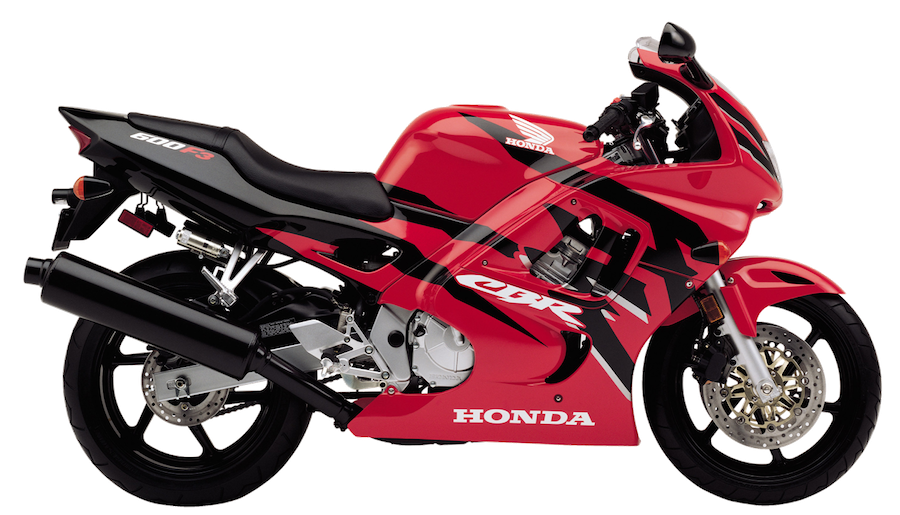Honda’s current CBR600RR can trace its roots back to 1987, when the mid-capacity Honda was sold with the model designation CBR600F – or Hurricane in the US. That first generation CBR600 with its 85-horsepower liquid-cooled, four-cylinder powerplant was an capable all-round motorcycle that won a legion of fans around the globe.
Although the 1996 Honda CBR600F is the subject of this Second-hand feature, it’s worth looking at the history of the model – both before and after the CBR600F3 of 1996.
In Australia that late-1980s CBR600F was arguably ahead of its time in a market where bigger was perceived as better. Despite positive reviews by the motorcycle press of the day, sales of the CBR600 were comparatively slow when compared to markets like Europe.
At the time of its launch in 1987 the CBR600 sold for $6500. At that time Honda’s VFR750 could be obtained for $7380 – just $880 more – with Honda’s superseded CBX750 available for a bargain $5250. Suzuki’s Katana 750, also a superseded model, could be had for $5999 in 1987.
Selling a 600 at a higher price than a 750 was always going to be a big ask, despite the CBR600 being a more modern design and a ‘better’ motorcycle than either the CBX750 or Katana.
The liking of the Australian market for bigger-capacity motorcycles is no doubt one of the reasons Honda Australia held off bringing the all-new CBR600F2 Down Under in 1992. Rave reviews in Europe and the US helped sway the local subsidiary to add the CBR600F2 to the Australian model line-up in 1993, and the rest, as they say, is history.
Honda’s CBR600 has gone through a number of incarnations since the 1992 CBR600F2, from CBR600F through to the current CBR600RR. The F2 scored ram-air in 1995 and became the F3, then an aluminium frame arrived in 1999. The new-look F4i arrived Down Under in 2001 and would last until 2006, selling alongside the CBR600RR, the latter introduced in 2003.
The common thread is that all variations have been strong sellers, with Honda Australia at one time selling the more ‘cuddly’ CBR600F alongside CBR600F4i, the latter also continuing to be sold alongside the narrower-focus CBR600RR in 2005-06. There were special editions too, among them a Rossi-replica CBR600F4i and a Ten Kate CBR600RR.
Complicating matters is that the CBR600 scored different model designations around the globe, with the Australian F4i a ‘Sport’ in some markets. That makes buying a second-hand CBR600 a challenging prospect, as it pays to do some research to ensure what you’re buying is what’s been advertised correctly.
When the F3 was introduced in 1995 the colour combinations included Black with Uranus Violet and Chartreuse Yellow, as well as Ross White with Uranus Violet and Chartreuse Yellow. The Honda paintshop seemingly did the marketing department no favours!
The F3 differed from the F2 in having a dual-stage air induction system, more compact combustion chambers and a computer-controlled 3D-mapped ignition. The suspension was recalibrated and the brakes were stronger. Colour options were the only changes for 1996.
Back in 1996 narrow-focus RRs and YZF-R6s didn’t exist, and the F3 was a bike that could win on the racetrack on Sunday, be commuted to work during the week, then tour two-up the following weekend. The CBR600F was close to being the perfect all-round bike.
Honda has continuously evolved and improved a good thing, leading to the enviable reputation the CBR has developed. With the model already steeped in success, 1999 saw the frame upgraded to alloy on the FX/FY models. The shift from steel was significant, allowing the CBR to drop a whopping 15kg. Electronic fuel injection arrived in 2001 with the CBR600F4i (or FS).
Regardless of model, any CBR is up for whatever is thrown at it. All CBRs like to be revved, but they’ve been engineered to do just that. CBR600F3s (1995-98) are getting a little long in the tooth now, but a well-maintained one should continue to offer many kilometres of trouble-free ownership.

PRICE GUIDE
NEW PRICE
$12,300 (1996)
SECOND-HAND
$4000-$5600
WHAT TO LOOK FOR
Build quality on CBR600s is high, and the engine is robust. Check for the usual wear and tear on a motorcycle that has travelled long distances or been used for track days – swingarm and steering-head bearings; brakes and brake lines; tyre wear; leaking fork seals; rear shock absorber damping; noisy tappets; oil weeps around gaskets.
Oil weeps could indicate sustained high-speed track use or an over-heating engine.
Check for crash damage or gravel rash on frame rails that could indicate track abuse.
TRACK HISTORY
Honda’s CBR600F2 was an instant hit with racers and mid-capacity sportsbike riders when it arrived in Australia in 1993. The CBR600F2 won the inaugural Australian Supersport title in 1993 with Graeme Morris (not an official championship that year), then backed up with official championship wins in 1994 with Graeme Morris and 1995 with Dean Thomas.
Kevin Curtain broke the CBR sequence in 1996 on his Kawasaki ZX-6R before Shawn Giles bounced back to claim the title in 1997 on the CBR600F3.
In 2002 Shannon Johnson won the championship on a Honda CBR600F4i, with Adam Fergusson and Josh Brookes taking the CBR600RR to championship victory in 2004 and 2005 respectively.

SERVICE HISTORY
Honda’s CBR600 is a long-running design that has proven reliable and robust. Oil change intervals are recommended at 12,000km, with valve adjustment every 24,000km. Air-filter and sparkplug replacement will depend to some extent on the type of use. All the aforementioned tasks can easily be carried out by the home mechanic.











